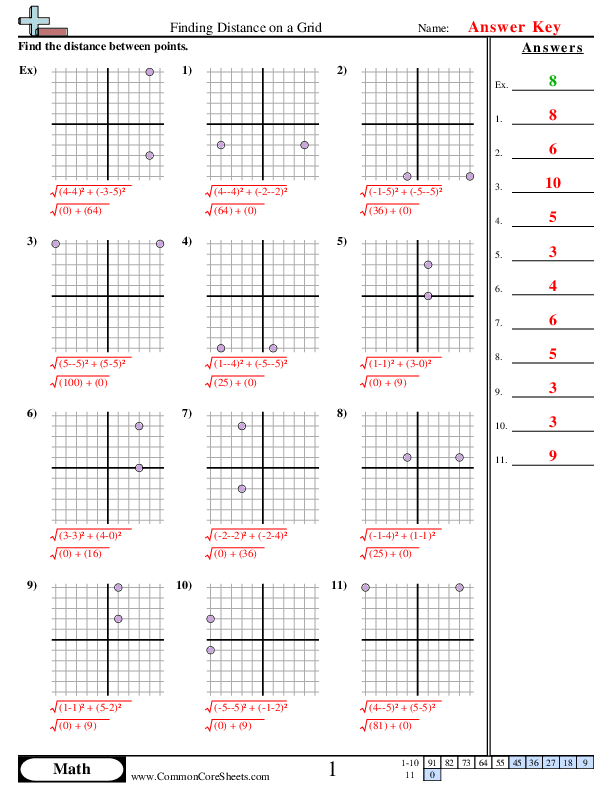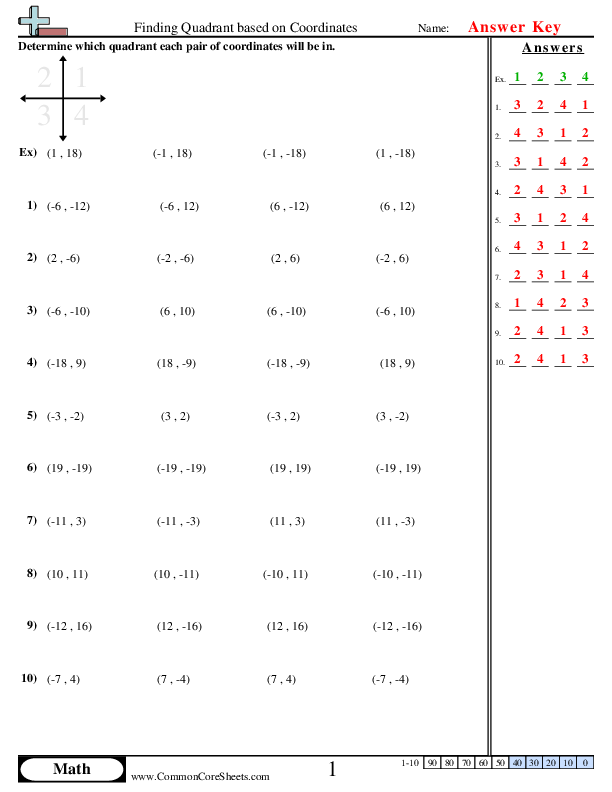Our graphing worksheets are the best on the internet for helping students learn how to graph data and interpret the results. These free worksheets cover a wide range of topics, including graphing positive and negative coordinates, reading a coordinate plane and many more. Our worksheets are designed to be easy to use and understand, making them perfect for students of all ages. Whether you're a teacher looking for the best graphing worksheets to use in your classroom, or a student looking to improve your graphing skills, these worksheets are the perfect resource. So why wait? Start using our graphing worksheets today and see the difference they can make in your understanding of this important topic!
Browse Sheets By Problem Type
×
Determining Coordinates
Link

Positive and Negative
6ns6c


×
Description:
"This worksheet is designed to teach children the concept of positive and negative coordinates in a fun, interactive way. Using geometric shapes and familiar objects like a star, heart, or moon, this customizable worksheet presents 20 problems ideal for learning via flashcards or distance education. With practice, students will master the math skill of reading coordinates effectively."

×
Student Goals:
Understanding of Coordinate SystemUpon the successful completion of this worksheet, the students will have a deeper understanding of the positive and negative coordinate system, a crucial concept in mathematics. They will learn the basics of graphing, addressing both the x and y coordinates, and how to plot points correctly using positive and negative numbers.Improved Problem Solving SkillsWork through the entire set of problems will help the students to strengthen their problem-solving skills. The 20 problems on the worksheet have been designed in such a way that they test the students' ability to interpret and work out solutions convincingly. Each problem presents a unique challenge, further motivating students to think critically and logically.Competency in Navigating 2D SpaceThe students will demonstrate a proficiency in navigating the two-dimensional space effectively. This skill will come in handy when carrying out analytical tasks in later grades, especially in subjects that require the use of diagrams and charts such as Geometry and Physics.Application of Knowledge to Real World ScenariosThe students will be able to apply the knowledge gained from the worksheet, not just in the academic context, but also in real-life scenarios. The understanding of coordinates is beneficial in a diverse range of fields, including Computer Science, Geography, Engineering, Architecture and more. This is, therefore, a significant step in equipping them with relevant skills for the future.Enhanced Math VocabularyStudents will further solidify their math vocabulary relevant to coordinate systems, including terms like 'axis', 'origin', 'quadrant', 'coordinates', 'positive', and 'negative'. Confident use of the appropriate mathematical language helps students to communicate their understanding effectively.Confidence and Independence in LearningCompleting the worksheet will also foster a notable level of confidence and independence in the students. Attempting, solving, and correcting errors all by themselves will encourage them to take charge of their learning process and not shy away from attempting challenging problems in future.



Finding Distance (Same X or Y)
6ns8


×
Description:
"This worksheet is designed to enhance children's understanding of distance calculation on a grid in mathematics. It provides 11 problem-solving tasks that guide kids through a step-by-step process of using coordinates to calculate distances. Tailored to accommodate different learning environments, the sheet can be customized for personal needs, converted into interactive flash cards, or integrated into distance learning curriculums to reinforce this crucial math concept in a fun and engaging way."

×
Student Goals:
Understanding Grid-Based CalculationsAfter completing this worksheet, students will have a better understanding of how to calculate distances within a grid. They'll have a better command of the mathematical concepts involved, bringing them closer to mastering the subject matter. Distance calculations on a grid are a critical part of mathematics and these exercises will immensely magnify their ability to handle them, pertinent to real-world applications like physical mapping, computer graphics, and data visualization.Problem Solving and Critical ThinkingBy successfully navigating through the problems in the worksheet, students will also develop enhanced critical thinking and problem-solving skills. Each task poses a unique challenge that requires careful consideration and mathematical reasoning. Thus, they will be capable of strategically tackling complex problems, developing a structured approach to break them down and derive solutions.: Proficiency in Mathematical OperationsThe worksheet addresses basic to advanced mathematical operations. Therefore, students will become more adept at executing these operations accurately and efficiently after multiple practices provided by the worksheet. Their proficiency in addition, subtraction, multiplication, and square operations will be noticeably improved.Applying Mathematical ConceptsThrough applying mathematical concepts to solve distance problems on grids, students will better understand and learn abstract mathematical ideas. Despite being simple arithmetic, the worksheet allows the students to understand the fundamentals of the coordinate system, geometry, and how to use two-dimensional spaces with ease.Enhancement of Math VocabularyIn the process of completing this worksheet, students will come across various key terms and symbols regularly used in mathematics. This exposure can lead to an expanded vocabulary in math language, enabling them to articulate mathematical problems better in the future.Confidence in MathSuccessfully completing the worksheet will help students build confidence in their mathematical abilities. Overcoming challenges and solving problems on their own will give them the confidence to approach even more complex math problems in the future, reducing math-anxiety, and cultivating a positive attitude towards the subject.


Determining Quadrants
Link

Finding Quadrant based on Coordinates
6ns6b


×
Description:
"This worksheet is designed to challenge children's understanding of math by finding the quadrant based on coordinates. With 10 diverse problems that utilize various coordinates, it helps sharpen children's skills in analyzing the quadrant of various points. Customizable based on your child's proficiency level, this educational resource can also be converted into flash cards for easy recall or used in distance learning setups, providing flexible and efficient learning approaches."

×
Student Goals:
Understanding of Quadrants and CoordinatesAfter completing this worksheet, students should have grasped the fundamentals of understanding the four quadrants of a Cartesian coordinate system. They should be able to identify which quadrant a point belongs to based on its coordinates. They would have developed a foundational understanding by practicing with different pairs of coordinates, thus gaining proficient knowledge of how each of the four quadrants is distinctly defined by negative and positive values of x and y coordinates.Enhanced Analytical SkillsThe worksheet would have honed students' analytical thinking skills. Decoding the quadrant from given coordinates is not just about applying a formula, but also about logically interpreting the values. Therefore, by consistently practicing problems of this nature, students inadvertently enhance their logical reasoning and analytical skills. They learn to pay close attention to detail and draw accurate conclusions based on the given data.Preparation for Advanced Mathematical ConceptsKnowing how to decipher quadrants from coordinates is a preliminary yet crucial step towards understanding more complex areas of mathematics. Completion of this worksheet would mean that the students are ready to delve into more advanced mathematical topics that require a good grasp of coordinates and the Cartesian system, such as geometry, vectors, and even calculus. This understanding provides them with a firm base, aiding them in solving more complex problems in the future.Application and Problem-Solving SkillsBy the end of this worksheet, students would also have an enhanced ability to apply their theoretical knowledge to practical mathematical problems. They should be able to read a coordinate pair, identify the quadrant, and use their findings to solve various math problems. This not only increases their adeptness at problem-solving but also boosts their confidence in handling more complex mathematical scenarios.Increased Confidence and Self-Efficacy in MathematicsFinally, successfully finding quadrants based on coordinates can bolster students' confidence in their mathematical abilities. Accomplishing such tasks can slowly but surely eliminate any math-related anxiety, fostering a healthy and positive attitude towards the subject. The confidence gained from overcoming challenges like these contribute to their overall self-efficacy, leading to better academic performance broadly over time.





